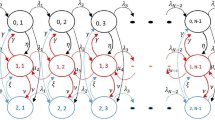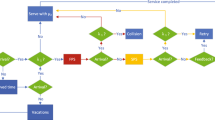Abstract
This paper presents the derivation of an analytical model for a multi-queue nodes network router, which is referred to as the multi-queue nodes (mQN) model. In this model, expressions are derived to calculate two performance metrics, namely, the queue node and system utilization factors. In order to demonstrate the flexibility and effectiveness of the mQN model in analyzing the performance of an mQN network router, two scenarios are performed. These scenarios investigated the variation of queue nodes and system utilization factors against queue nodes dropping probability for various system sizes and packets arrival routing probabilities. The performed scenarios demonstrated that the mQN analytical model is more flexible and effective when compared with experimental tests and computer simulations in assessing the performance of an mQN network router.
Similar content being viewed by others
References
L. Guan, I. U. Awan, M. E. Woodward, X. G. Wang. Discrete-time performance analysis of a congestion control mechanism based on RED under multi-class bursty and correlated traffic. Journal of Systems and Software, vol. 80, no. 10, pp. 1716–1725, 2007.
C. W. Dai, S. H. Yang, R. Knott. Data transfer over the internet for real time applications. International Journal of Automation and Computing, vol. 3, no. 4, pp. 414–424, 2006.
S. Floyd, V. Jacobson. Random early detection gateways for congestion avoidance. IEEE/ACM Transactions on Networking, vol. 1, no. 4, pp. 397–413, 1993.
M. E. Woodward. Communication and Computer Networks: Modeling with Discrete-time Queues, London, USA: Pentech Press, 2005.
H. Abdel-jaber, F. A. Thabtah, M. E. Woodward, A. Abuali. Performance evaluation for DRED discrete-time queuing network analytical model. Journal of Network and Computer Applications, vol. 31, no. 4, pp. 750–770, 2008.
H. Abdel-jaber, M. E. Woodward, F. Thabtah, M. Etbega. A discrete-time queue analytical model based on dynamic random early drop. In Proceedings of the 4th IEEE International Conference on Information Technology: New Generations, IEEE, Las-Vegas, USA, pp. 71–76, 2007.
J. Aweya, M. Ouellette, D. Y. Montuno. A control theoretic approach to active queue management. Computer Networks, vol. 36, no. 2–3, pp. 203–235, 2001.
T. G. Robertazzi. Computer Networks and Systems: Queuing Theory and Performance Evaluation, 3rd ed., NewYork, USA: Springer Verlag, 2000.
L. Hoflack, S. De Vuyst, S. Wittevrongel, H. Bruneel. System content and packet delay in discrete-time queues with session-based arrivals. In Proceedings of the 5th International Conference on Information Technology: New Generations, IEEE, Las Vegas, USA, pp. 1053–1058, 2008.
F. Baccelli, D. R. McDonald. A stochastic model for the throughput of non-persistent TCP flows. Performance Evaluation, vol. 65, no. 6–7, pp. 512–530, 2008.
I. Awan, A. Yar, M. E. Woodward. Analysis of queuing networks with blocking under active queue management scheme. In Proceedings of the 12th International Conference on Parallel and Distributed Systems, IEEE, Minneapolis, USA, vol. 2, pp. 61–68, 2006.
L. Wang, G. Min, I. Awan. Modeling active queue management with different traffic classes. In Proceedings of the 20th International Conference on Advanced Information Networking and Applications, ACM, Vienna, Austria, vol. 2, pp. 442–446, 2006.
H. Al-Bahadili. On the use of discrete-event simulation in computer networks analysis and design. Handbook of Research on Discrete-Event Simulation Environments: Technologies and Applications, E. M. O. Abu-Taieh, A. A. El-Sheikh, Eds., New York, USA: Information Science Reference, pp. 418–442, 2009.
J. Ababneh. Development of a Discrete-time DRED-based Multi-queue Nodes Network Analytical Model. Ph.D. dissertation, The Arab Academy for Banking & Financial Sciences, Amman, Jordan, 2009.
M. Joshi, A. Mansata, S. Talauliker, C. Beard. Design and analysis of multi-level active queue management mechanisms for emergency. Computer Communications, vol. 28, no. 2, pp. 162–173, 2005.
M. S. Hasan, C. Harding, H. Yu, A. Griffiths. Modeling delay and packet drop in networked control systems using network simulator NS-2. International Journal of Automation and Computing, vol. 2, no. 2, pp. 187–194, 2005.
W. H. Press, S. A. Teukolsky, W. T. Vetterling, B. P. Flannery. The Art of Scientific Computing, 3rd ed., UK: Cambridge University Press, 2007.
Author information
Authors and Affiliations
Corresponding author
Additional information
Hussein Al-Bahadili graduated from University of Baghdad, Iraq in 1986. He received the M. Sc. and Ph.D. degrees from University of London (Queen Mary College), UK in 1988 and 1991, respectively. He is currently an associate professor at Petra University, Jordan. He is also a visiting researcher at the Centre of Wireless Networks and Communications (WNCC), University of Brunel, UK.
His research interests include computer networks design and architecture, routing protocols optimizations, parallel and distributed computing, cryptography and network security, data compression, software, and web engineering.
Jafar Ababneh graduated from University of Mu’ta, Jordan in 1991. He received the M. Sc. degree from University of Yarmouk, Jordan in 2005 and the Ph.D. degree from the Arab Academy for Banking & Financial Sciences (AABFS), Jordan in 2009. His field of study is development and performance evaluation of multiqueue nodes queuing systems for congestion avoidance at network routers.
His research interests include wireless communications, computer networks, artificial intelligence and expert system, knowledge base systems, security systems, and information retrieval.
Fadi Thabtah received the Ph.D. degree from University of Bradford, UK in 2005. He is currently the head of Management Information System (MIS) Department at Philadelphia University. He was active in research as a member of the modeling optimization scheduling and intelligent computing (MOSAIC) research group at University of Bradford, UK, where he investigated the use of association rule data mining in real-world scheduling problems. Outside academia, he works as a database administrator for an insurance company and as a software developer responsible for the development of an inhouse billing system. He remains active in software development, having recently developed a system for credit cards coring.
His research interests include the investigation and development of new data mining and machine learning techniques, which bridge the gap between the theory and practice of decision making using artificial intelligence techniques.
Rights and permissions
About this article
Cite this article
Al-Bahadili, H., Ababneh, J. & Thabtah, F. Analytical modeling of a multi-queue nodes network router. Int. J. Autom. Comput. 8, 459–464 (2011). https://doi.org/10.1007/s11633-011-0604-2
Received:
Revised:
Published:
Issue Date:
DOI: https://doi.org/10.1007/s11633-011-0604-2




